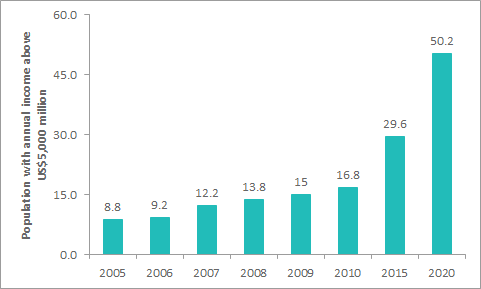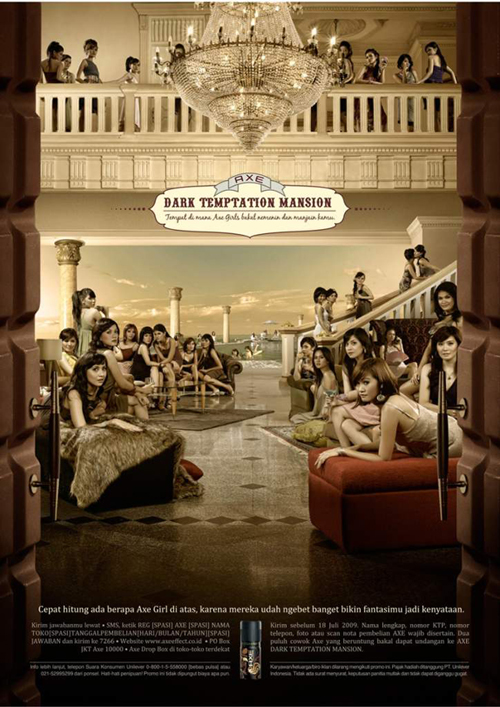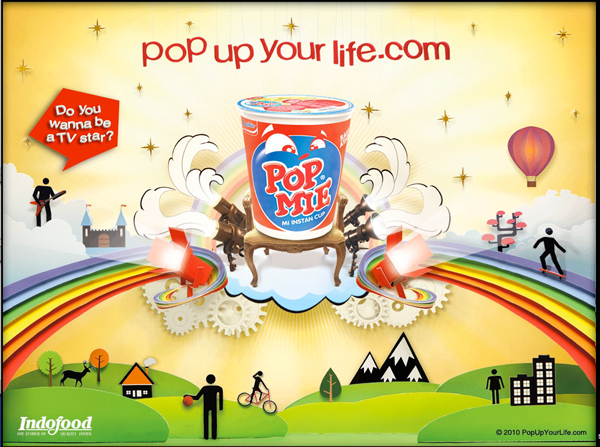Marketing in Indonesia – Market Overview and Review of Best Practice
It's not so long ago that Indonesia was known as widely for its currency crisis and vulnerability to natural disaster as for its fine beaches and nasi goreng. In the past decade, however, democracy, growing wealth and economic stability in spite of global chaos has transformed this Southeast Asian archipelago from a country on the brink of collapse to a powerhouse of growth and consumer demand.
The fastest-growing market in the ASEAN group of countries, Indonesia was identified in 2005 as being among the 'Next 11' world markets – those after the BRIC giants that had the most promising outlook for investment and future growth. This is a market fuelled as much by domestic demand as by exports, meaning that, along with India and China, it's less susceptible to damage by sudden shifts in international demand. Indonesia has the world's fourth largest population—nearly 240 million people – and its economy grew a healthy 6% in 2010, according to the IMF. Growth in Q1 of 2011 was expected by the Indonesian Central Bank to reach 6.4%, as exports rise and demand at home intensifies, and some forecasts expect it to be one of the biggest five economies in the world by 2030.
This is a young market; vast numbers of Indonesians have not known war or recession. Having grown up with increasing prosperity, they have no reason to expect anything less in the future. When they have money, they tend to spend it, with saving being a fairly low priority. Euromonitor analysts describe Indonesia as "bursting with vitality and among Asia's most dynamic countries". Over 37% of the population is aged 15 to 29 – nearly 85 million young people who are avid consumers and are hugely excited by new technology. This remains, however, a country of huge contrast; Twitter is used by about 20% of the population, believed to be one of the highest penetration rates in the world, yet only 29% of households nationwide have a refrigerator. As prosperity grows, however, so the ranks of the middle class swell.

Source: Euromonitor
Synovate's PAX survey, which monitors the acquisitions and attitudes of Asia's wealthiest 20% of society based on monthly income, shows that, as of November 2010, 62.9% of affluent consumers in Jakarta own a car, but 27.1% planned to buy one in the coming 12 months, the second-highest in the region behind only Bangkok residents (28.6%).
BRAND AMBITIONS
The opportunity here for multinationals and for strong local brands is clear, and investment in goods production and marketing is unsurprisingly strong. While 'growing up' toddler milk is the biggest mover in the drinks category here, as parents look to give their children the best possible start, soft drinks too are big business. Local producer PT Sinar Sosro and international PT Coca-Cola Amatil Indonesia are both targeting sales growth of 10-12% this year, and are increasing production capacity to meet anticipated demand.Coca-Cola Amatil, the Australian-based bottler and distributor for Coca Cola across the Pacific region, is investing around US$100 million in Indonesia over three years, doubling the company's investment in the country, with plans to expand into new products and categories. At the same time, L'Oréal Group, the world's largest cosmetics and beauty company, is building its largest factory in the world in Indonesia, investing US$100 million this year, half of that in the new facility. It is aiming for 30% growth in annual sales in the country, and is hoping to attract 50 million new customers in Indonesia by 2020.
As individuals get a little more money in their pockets, they start to consider spending money on new products. Unilever, for example, is hoping to encourage Indonesians to start treating themselves to ice-cream more often. While many Asian markets are among the world's biggest ice-cream buyers, consumption per capita is among the lowest in Indonesia, with the low penetration of fridges probably a factor; by far the majority of sales are impulse, single-serving buys rather than packs bought for consumption at home. Unilever hopes Indonesians will take to Wall's Cornettos, Paddle Pops and other frozen goodies, and has been investing heavily in marketing them in the past year. The company has also launched ice-cream counters in malls to boost sales, growing both market share and the overall size of the market.
For foreign brands with a more established hold on the market, strategies involve building on existing loyalties. LG, for instance, recently ran a cross-platform campaign to mark the electronics brand's 20th year in the country. In ads showing the role of LG products in enriching family life, the company thanked consumers for making them the number one electronics brand in the country, one that sells an LG product every six seconds there.
ADSPEND SURGE
As brands local and foreign seek to capture a greater slice of this growing market, investment in advertising is booming. Overall adspend in 2010 grew 23% to a total of Rp. 60 trillion (US$6.9 billion). That was the country's strongest adspend growth since 2006, largely due to natural growth but also fuelled by additional spend around the World Cup finals in the summer, when Nielsen figures show spend in June and July was up 30%. In fact, the 10 most-viewed programmes all year were all football events, both World Cup and the AFF Suzuki Cup, where Indonesia's national team reached the finals. Per capita adspend remains low by world standards, however, with spend in Indonesia only a tenth of spend per capita in Australia, and less than half of that spent per capita in China.Telecommunications services and equipment brands are now the country's biggest investors in advertising, taking over from drinks brands and personal care items, and eclipsing spend by the cigarette industry, which just five years ago was in the top two categories for adspend. Indonesia is home to about 43 million smokers (about 57% of men and 5% of women), and the sector is highly lucrative. Spending by the industry on advertising was reined in last year, however, when legal restrictions on advertising, which until then had been loose by international standards, became more extensive.
| Top 10 Categories in All Media Category | Y2010 | Change |
|---|---|---|
| Telecommunication | 5,550 | 43% |
| Politics | 2,984 | -18% |
| Corporate Ads & Social Services | 2,380 | 23% |
| Clove Cigarettes | 1,984 | 14% |
| Motorcycles | 1,889 | 19% |
| Finance | 1,859 | 46% |
| Hair Care Products | 1,837 | 20% |
| Facial Care Products | 1,568 | 32% |
| Snacks | 1,384 | 31% |
| Media & Production House | 1,320 | 12% |
| Top 10 Spenders in All Media Product | Y2010 | Change |
|---|---|---|
| Excelcomindo XL | 593 | 66% |
| Telkomsel – All SIM Card | 538 | 79% |
| Telkomsel Simpati | 438 | 198% |
| Telkomsel Kartu AS | 398 | 125% |
| AXIS | 396 | 6% |
| Indosat M3 | 320 | 13% |
| Local Government Candidates | 309 | 673% |
| ESIA | 296 | 24% |
| Sedaap – Instant Noodle | 291 | 34% |
| AQUA – Mineral Water | 280 | -6% |
discount or promo, etc.), in Rp. Billion
THE DIGITAL OPPORTUNITY
Where these brands are choosing to advertise is a story that says a great deal about the way Indonesia is developing. GroupM's This Year Next Year report shows that TV remains the dominant advertising medium, taking 60.4% of total adspend, and with revenue growth in 2011 forecast to hit 25%.Newspapers take roughly a quarter of spend (growing at 15% this year), radio, magazines, outdoor and cinema each account for less than 3% of spend. But it's the spend going into online media that's really exciting. This year, it will only account for 8.1% of spend, but the money brands are injecting into it, and especially into social media, which accounts for about 80% of all online adspend, is expected to grow 200% this year.

Source: GroupM 'This Year Next Year'
| % shares of media | 1999 | 2000 | 2001 | 2002 | 2003 | 2004 | 2005 | 2006 | 2007 | 2008 | 2009 | 2010f | 2011f |
|---|---|---|---|---|---|---|---|---|---|---|---|---|---|
| TV | 63.7 | 64.0 | 61.7 | 62.9 | 65.2 | 64.8 | 68.8 | 68.7 | 65.9 | 63.3 | 60.5 | 61.4 | 60.4 |
| Radio | 3.4 | 3.3 | 3.4 | 3.1 | 2.9 | 2.4 | 2.1 | 2.1 | 2.1 | 1.9 | 1.8 | 1.5 | 1.2 |
| Newspapers | 22.6 | 23.7 | 25.1 | 25.0 | 23.7 | 23.5 | 20.6 | 20.6 | 23.6 | 26.1 | 28.4 | 27.0 | 24.4 |
| Magazines | 5.3 | 5.4 | 5.9 | 5.4 | 5.0 | 4.6 | 4.1 | 4.1 | 3.9 | 4.0 | 4.0 | 3.5 | 2.9 |
| Cinema | 0.1 | 0.1 | 0.1 | 0.1 | 0.1 | 0.1 | 0.0 | 0.0 | 0.0 | 0.0 | 0.0 | 0.0 | 0.0 |
| Outdoor | 4.9 | 3.5 | 2.1 | 1.7 | 1.6 | 3.0 | 2.8 | 2.8 | 2.9 | 2.8 | 3.2 | 3.1 | 2.9 |
| Internet | 0.0 | 0.0 | 1.8 | 1.7 | 1.7 | 1.6 | 1.5 | 1.6 | 1.8 | 1.9 | 2.1 | 3.4 | 8.1 |
| Media total | 100 | 100 | 100 | 100 | 100 | 100 | 100 | 100 | 100 | 100 | 100 | 100 | 100 |
"TV is the most loved medium here – Indonesians spend at least three hours a day watching TV for information and entertainment. With television, we can reach at least 70% of the Indonesian audience, and more cheaply than with other media," says Henny Minarti, head of Mindshare's Indonesia office. "What's also appealing is the availability of pre- and post-campaign measurement, so accountability is easy to track."
But with mobile phones and cheap subscription packages that include all-you-can-eat data options, the media landscape is being transformed. Online gaming becomes accessible for the vast numbers of people who don't have a computer at home, and social networking is a massive phenomenon at all age levels. Euromonitor ranks Indonesians as the second-biggest population group on Facebook, behind the United States but ahead of Britain, and the third-biggest on Twitter. The last quarter of 2010 saw more than five million users from Indonesia join Facebook. Data from Facebook and GreyReview show that in January 2011, there were 32,129,460 registered Indonesian Facebook users, compared to 26,598,240 in October 2010. Twitter is an especially good fit for Indonesians because while English is widely spoken, especially on Java, the most populous and technologically advanced island, the local language, Bahasa Indonesia, uses text-friendly Roman script.
Nanda Ivens, who runs Edelman's digital practice in Indonesia, says the pace of growth in social networking is "just crazy". Location-based social networking, through sites like Foursquare, is now starting to take off. Virtually all of it is done via mobile. Handsets are cheap – so-called 'stupid phones', those without smartphone functions, are available for the equivalent of about $23. Clones of BlackBerries, known as Chinaberries, offer similar functions to the real thing but for less than half the price. "My driver has three phones and my maid has two," Ivens says, pointing out that this is not just a teen and twenty-something consumer but also older users, with over-55s proving to be big social networkers. 'Reunion fever' gripped Jakarta in 2009 as people reached out to old friends through Facebook, and it was a rare evening that any restaurant didn't have at least a table or two of reunited school friends. About 80% of broadband users connect to the internet via mobile.
User-generated media is also thriving, says DD 'Lulut' Asmoro, President of JWT Indonesia. Despite the need for pricey hardware – digital cameras or video cameras – a recent campaign for local potato chip brand Chipato attracted a response far higher than anticipated. Consumers were invited to upload their interpretation of the brand's belief that life should never be flat. The US$100 daily prize for the best entries probably helped motivate contributors.
The Unilever men's personal care brand Axe ran a highly successful word-of-mouth online campaign to support the launch of a new variant in 2009, which began with the creation of an online video that created an urban legend about a secret place where men were entertained by beautiful women. The video drove people to a blog, where entries made it seem that this place, The Mansion, was real, but known only to a select few people. After four weeks, the blog let it be known that it was an Axe promotion. The campaign attracted more than 65,000 page views in three months, and had 9,580 participants.

All this online advertising activity has begun to have an effect on more traditional media, says Minarti. "The sad side is that the client doesn't find extra money to spend on digital - the total remains the same, and digital spending is primarily taking from magazines and newspapers, and a little from TV or outdoor," he says. "It's made these media more flexible in the way they sell, however. They're more open to new, breakthrough executions, bundling cross-platform deals and giving special rates for long-term commitments and certain volumes."
The brands that are investing in new media are finding themselves among the most talked about online. Edelman and Brandtology's Digital Brand Index (DBI 10.3) tracks 53 of the largest technology brands across 467 online channels. Technology brands perform extremely well in the online talkability stakes, and of the ranking's top-10 'buzziest brands', nine have a local Twitter presence: Nokia, Telkomsel, Xl Axiata, Indosat, Samsung, Telkom, Intel, Bakrie Telecom and Sony. Some brands have several, specialist Twitter accounts for different purposes, such as customer service and information on specific products.
THE IMPORTANCE OF RURAL CONSUMERS
While there is wealth in this market, and increasing numbers of people with money to spend, there remain vast numbers of people on very low incomes, and rural consumers who live incredibly simple, Tweet-free lives. Electricity is not even available to every home in the nation.| Historic/forecast % penetration | 2009 | 2010 | 2011 | 2015 |
|---|---|---|---|---|
| Possession of Colour TV Set | 86.5 | 88 | 89.3 | 93.1 |
| Possession of Mobile Telephone | 44.7 | 49.4 | 53.4 | 64.5 |
| Possession of Personal Computer | 7.1 | 7.8 | 8.6 | 11.7 |
| Possession of Refrigerator | 27.7 | 28.7 | 29.7 | 33.2 |
| Historic/ Forecast - '000 | 2009 | 2010 |
|---|---|---|
| Passenger Cars in Use | 10605 | 11607.7 |
| New Registrations of Passenger Cars | 164.8 | 168.6 |
Brands that make an effort to deliver products and communications that speak to the rural consumer have shown it can pay dividends. This is one of the few global markets where a local brand outsells Coca-Cola in the soft drinks category – tea brand Teh Botol Sosro commands a bigger market share than the US giant.
Understanding that the vast majority of smokers still smoke clove 'kretek' cigarettes rather than Western-style sticks, Marlboro launched a kretek of its own in 2007. McDonald's Indonesia has a chicken-and-rice dish on the menu in addition to standard burger fare, and Kraft has had a hit with its Biskuat biscuits, fortified with calcium and vitamins to provide affordable nutrition, and nutritional drink Milkuat, which sold in excess of 10 million bottles in its first three months. Affordable pack sizes, down-to-earth communications and appealing promotions are much of the key to success in the most rural areas.
MARKETING SUCCESS
This is a market that's yet to grow cynical and jaded about advertising. "Most of what you see is still pretty silly and cheesy," says one old Jakarta hand. "It's really quite an innocent market. Mobile operators can walk up to people in a mall and ask people for their phone numbers and email addresses, and plenty of people will give it to them," he says.Yet creative in Indonesia are starting to push new boundaries, and just last year the WPP agency Y&R Jakarta became the first Cannes Gold Lions winner from Indonesia, with its outdoor work for LG.
Synovate's PAX survey found that affluent Indonesians are less flashy than other wealthy Asians; less than half said they enjoyed it when others saw how successful they were, compared to the 55% average for the region.
Few brands take a strong position on social or political issues, though the few that do can have a big impact. A local cigarette brand at the end of the Suharto era ran a campaign with the tagline that, loosely translated, meant 'Stop the bullshit'. More recently and less controversially, local Unilever tea bag brand SariWangi injected fresh consumer interest into what was already a market-leader by urging women to rethink their relationship with their husbands and use tea as a means of sharing, rather than serving. "This campaign really captures the spirit of the times and brings to life what many women are feeling about their changing role in the world," says Renuka Jaypal, chairman of Ogilvy Indonesia. The 'Let's Talk' campaign used relationship columns in print, TV ads, roadshows and digital to position SariWangi as the product that gave voice to women's wish for greater dialogue and closeness with their husbands. Personal stories were submitted online and have been compiled into a book that serves as a kind of girlfriend-bonding tool. (Click here for full details of SariWangi Tea campaign.)
Ann Lee of DDB Indonesia Group says humour is used frequently, but it tends to be more slapstick than ironic. BNI, the local bank, got talked about online for its use of irony, simply because it's so seldom seen. Far more commonplace is the approach used in Indosat's TV commercial for its Mentari mobile phone brand. This used sitcom-style humour, complete with canned laughter, for its family-holiday-gone-wrong demonstration of how a mobile can help users out of a sticky situation.
Sport is also big business, and sport sells products. The football World Cup had huge viewership last year. Motorcyclist Valentino Rossi was in Indonesia in 2010 for a Yamaha promotion, and several English Premier League football clubs have websites tailored specifically for Indonesia.
CASE STUDY 1: BANGO SOY SAUCE
Agency: Lowe Indonesia
Bango is a local brand of sweet soy sauce known as kecap, an ingredient used widely in Indonesian cooking. The brand wanted to convince consumers that this was the best sauce to use to make authentic Indonesian dishes, and position itself as the food that unites not just families but the country, filling hungry stomachs and hearts too.
The brand initiated a cross-platform initiative around cooking, including a weekly TV cooking programme that as well as giving cooking tips and demonstrations, talked to hawkers about their secret techniques and discussed the heritage of well-known dishes. The campaign moved on to discovering the nation's favourite dish, focused primarily on mothers identifying their families' favourite meals. Voting could be conducted via Facebook, Twitter and SMS, as well as offline.
The campaign came to a crescendo with a branded food festival in three major cities, which attracted more than 500,000 visitors and had a significant effect on consumers' view of the brand as providing 'a great taste experience' compared to rival brands. The brand's market share is its highest ever.
CASE STUDY 2: BLACKBERRY AND FACEBOOK
Agency: Edelman Indonesia
BlackBerry saw explosive growth in Indonesia in 2009, partly fuelled by the popularity of its BlackBerry Messenger function. The brand's Facebook page has attracted a following of about 840,000 fans, making it one of the most popular brand pages in the country.
Nanda Ivens of Edelman explains that the page became a kind of hub for customers, where they could ask questions, link to videos on YouTube or pictures on Flickr. "Some marketers see Facebook as another place for them to push their ads out," Ivens says. With this campaign, which ran over a year-long period, the Indonesian attraction to be part of a community was served by the brand, which rewarded fans with not only a place to chat and be part of a common-interest group but also gave them access to content that wasn't available to a broader audience.
The first peek at the Playbook tablet device was available through the Facebook site, and short films were made about how BlackBerry was using its Messenger function – an association of breastfeeding mothers was one of the groups featured, as was a group of tattoo artists. "There were some amazing stories," Ivens says, some of which were picked up and featured on technology blogs.
CASE STUDY 3: POP MIE NOODLES
Agency: JWT
This noodle brand, part of the Indofoods group, wanted to position itself as the brand that captured the spirit of the youth generation. Celebrating the fact that young people see themselves as creators, collaborators, connectors and at times even celebrities, the brand created an online playground for them, where they could play, create and be famous.
TV and press ads directed people to the web site Popupyourlife.com. Once on the site, users could upload a picture of themselves or take one with a webcam and see themselves become the star of one of three 15-second Pop Mie video ads, then share the results with friends via Facebook and Twitter. The site attracted more than 10,000 daily visitors – despite the fact that participation relied on having access to a camera and also having good-bandwidth broadband.
JWT's Lulut Asmoro says the aim of the campaign was to build affinity with young consumers rather than boost short-term sales. "These are cool ads, and if people see them as cool ads, then hopefully they see Pop Mie as a cool brand."

ABOUT THE AUTHOR
Jo Bowman writes on marketing and research for specialist magazines in Europe and Asia, as well as on broader business issues and trends. She has worked in Australia, Hong Kong and Italy, and is now based in the UK.Email her at jo@rjbmedia.net
http://www.warc.com/Content/ContentViewer.aspx?ID=cd061e75-0ede-432b-9bb4-d12d31370e75&ID=cd061e75-0ede-432b-9bb4-d12d31370e75&MasterContentRef=cd061e75-0ede-432b-9bb4-d12d31370e75

Have you consider starting an monthly news letter. It would take your site to its potential. harga saham
ReplyDeleteBrand building is one of the major aims of modern brands because if the brand’s name is not reaching out to the right customers then the sales will never be increased. So it is important to use the methods that are effective. I believe that the techniques like SMM and SEO can be highly useful. The facebook ads services are helping me thoroughly with my new brand’s promotion.
ReplyDelete